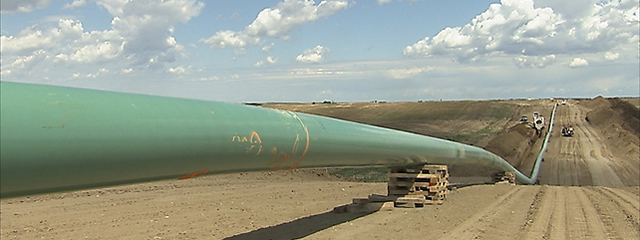On Monday the Keystone XL pipeline project crossed another hurdle when legislation approving construction of the proposed line to connect Canadian oil sands crude with Gulf Coast refineries was passed by the United States Senate.
The bill sailed through 63 votes to 32 in the Senate, which is now in the hands of the Republicans following November mid-term elections, along with the House of Representatives, which passed the same Keystone legislation last week.
With the bill well on its way to becoming law, it will up to President Obama to decide on whether or not to veto it, a decision he has held off for six years. Obama has criticized the project as adding to greenhouse gas emissions, despite an environmental assessment to the contrary by the State Department released a year ago, and because he argues it would help Canadian producers to deliver crude for export, against the claims of the proponent, TransCanada Corp, which maintains the oil will be processed in US refineries and consumed domestically.
While the political machinations of Keystone, with all the horse trading it inevitably entails, certainly make for some excellent headlines, an equally pressing question is whether the project is even viable with today's oil prices, which dropped further on Monday to below $46 a barrel in North America.
The rationale for Keystone was a way to bring together booming US oil production, and to a lesser extent, production from the oil sands in Northern Alberta, to Gulf Coast refineries that were facing declining imports from Mexico and Venezuela. The project was first proposed in 2008 and was supposed to begin carrying 830,000 barrels a day in 2012.
But the market didn't wait for the pipeline to be built, and landlocked Canadian crude has found its way to Texas and Louisiana refineries by rail instead. Canadian oil exports by rail tripled to a record 182,000 barrels a day in the third quarter, according to Canada's National Energy Board. The United States has also been importing Canadian oil like gangbusters, showing that the trade will happen with or without the pipeline extension (Keystone XL is an addition to the existing pipeline). Data from the US Energy Department showed US imports of Canadian crude reached a record 3.1 million barrels a day in September.
So with some of the project's goals already being met, in terms of increased production flowing from Canada to the US, the question has become, why is a pipeline needed anymore? And now, with the oil price down more than 50 percent since June, Canadian production is certain to fall, lessening demand for oil transportation and thus casting doubt on the economics of the project according to observers.
“Right now with oil prices down and a glut of oil on the global marketplace, the answer is no, we don’t need Keystone right now,” Phil Flynn, senior market analyst at the Price Futures Group in Chicago, told a reporter from the San Luis Obispo Tribune last week.
Some are predicting low oil prices could delay the project even if Obama passes it, or it could be shelved altogether.
Chris Lafakis, an energy economist for Moody's Analytics, equated the situation with Keystone to an earlier proposal to build a natural-gas pipeline from Alaska to the Midwest. Despite being approved by then-Governor Sarah Palin, the pipeline was never built due to new gas supplies which pushed prices down by two-thirds. "If oil were to stay as cheap as it is right now, you might very well get that Palin pipeline scenario," Lafakis said.
Ironically, the low oil price could also be used as a justification by Obama to cancel Keystone, according to a low-price scenario envisioned by the State Department when it made the determination that constructing the pipeline wouldn't increase GHG emissions.
As reported by the Globe and Mail, in its analysis the State Department concluded that with prices above $90 a barrel, approval of the pipeline wouldn't affect oil sands production because the oil would find its way to market anyway through more expensive means i.e. rail.
However with a lower oil price, the State Department concluded that the project would be more attractive to producers (about $8 per barrel less than by rail), leading them to boost production and thus increase emissions:
“Oil sands production is expected to be most sensitive to increased transport costs in a range of prices around $65 to $75 per barrel,” it said. “Assuming prices fell in this range, higher transportation costs could have a substantial impact on oil sands production levels … Prices below this range would challenge the supply costs of many projects, regardless of pipeline constraints, but higher transport costs could further curtail production.”
For its part, the company behind the pipeline, TransCanada, refuses to yield on its rationale for the pipeline. CEO Russ Girling told the Globe and Mail that lower crude prices make the project more attractive to producers both in Canada and the US, who are looking for the most cost-effective way to transport oil to refineries.
Further, Girling pointed out that low prices haven't reduced the need for the pipeline either. “On the contrary, TransCanada has 100 per cent of its original contracts still in place and producers are keen to reduce their transportation costs in order to increase per-barrel revenue, or netback,” the Globe reported on Sunday.
It would certainly be ironic if after six years of delay, rhetoric and political maneuvering, what really kills Keystone XL is the oil price, not Obama nor the environmental movement that has lobbied so hard against the project.
Whether or not the pipeline is passed by the White House, it appears that the economics of Keystone XL are just as muddy as its politics.


























Laissez un commentaire Votre adresse courriel ne sera pas publiée.
Veuillez vous connecter afin de laisser un commentaire.
Aucun commentaire trouvé